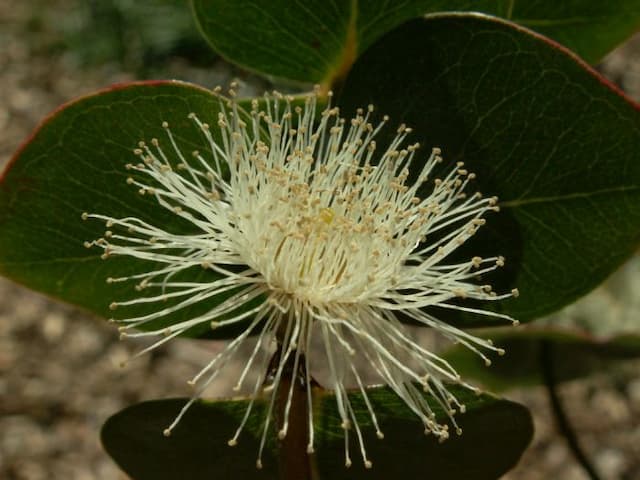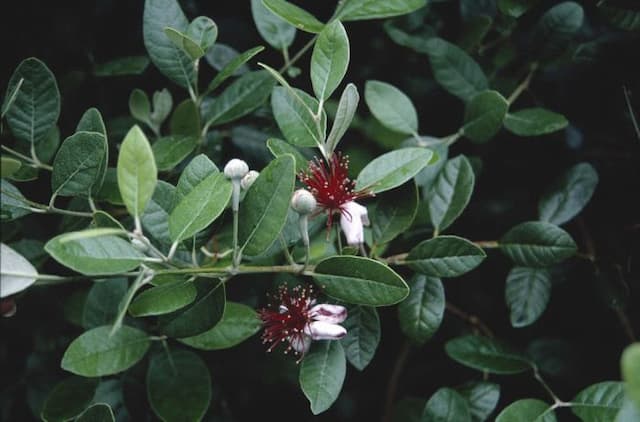Alpine Cider Gum Eucalyptus archeri

ABOUT
Eucalyptus archeri, commonly known as Alpine Cider Gum, is a species well-adapted to cold environments. This plant has a characteristic appearance that is highlighted by a smooth and sinuous bark. The bark itself exhibits a creamy white to grey color that can shed in strips, revealing a polished, glossy surface beneath. Its leaves are quite distinctive. In their juvenile stage, they are round, glaucous, and have a blue-green hue that contrasts nicely with the bark. As the plant matures, the leaves elongate and take on a sickle shape, becoming more of a grey-green in color. These adult leaves are aromatic when crushed, releasing the typical Eucalyptus scent. The Alpine Cider Gum also bears flowers which have a fluffy, white appearance and are quite attractive to birds and bees. These flowers eventually give way to woody fruits, commonly referred to as gumnuts, which are small and capsule-like with a conical shape. Each gumnut is covered by a protective operculum that pops off as the fruit matures to release seeds. The overall form of the plant is generally upright and symmetrical, contributing to its ornamental appeal. The foliage arrangement along the branches is relatively spread out, giving it an open canopy which allows light to filter through. Moreover, the Eucalyptus archeri has a robust root system which aids in its survival in its preferred environments. Overall, this plant combines a graceful structure with functional attributes, making it both striking and resilient.
About this plant
 Names
NamesSynonyms
Alpine Cider Gum, Archer's Gum
Common names
Eucalyptus archeri.
 Toxicity
ToxicityTo humans
Eucalyptus, generally, contains compounds that are toxic to humans if ingested. While Eucalyptus archeri is primarily grown for ornamental purposes and not commonly implicated in human poisoning, the leaves and oil of eucalyptus plants can cause serious symptoms if consumed. Ingestion can lead to gastrointestinal discomfort, nausea, vomiting, diarrhea, and in severe cases, can result in central nervous system depression and cardiotoxicity. Always exercise caution and keep eucalyptus out of reach of children who might be tempted to chew on the aromatic leaves.
To pets
Eucalyptus is toxic to pets, including dogs and cats, and care should be taken to prevent them from ingesting any part of the plant. Symptoms of eucalyptus poisoning in pets may include drooling, vomiting, diarrhea, depression, weakness, and in severe cases, seizures and collapse. Ingesting eucalyptus can also potentially cause liver damage. If you suspect your pet has ingested eucalyptus, seek veterinary care immediately.
 Characteristics
CharacteristicsLife cycle
Perennials
Foliage type
Evergreen
Color of leaves
Green
Flower color
White
Height
20 feet [6 meters]
Spread
10 feet [3 meters]
Plant type
Tree
Hardiness zones
8
Native area
Australia
Benefits
 General Benefits
General Benefits- Ornamental Value: Eucalyptus archeri is often used in landscaping for its attractive peeling bark and silver-green foliage.
- Drought Resistance: The species is well-adapted to dry conditions, making it suitable for xeriscaping and water-wise gardens.
- Frost Tolerance: Eucalyptus archeri can tolerate mild frosts, allowing it to be grown in cooler climates where many eucalypts would not survive.
- Wildlife Habitat: The tree provides shelter and food for native birds and insects, supporting biodiversity.
- Windbreak: When planted in rows, Eucalyptus archeri can act as a windbreak, offering protection for gardens and properties.
- Fast Growth: The plant grows relatively quickly, which can be advantageous for creating structure in new gardens or landscapes in a short period of time.
- Timber Production: The wood of Eucalyptus archeri can be used for various purposes, including furniture and craftwood.
 Medical Properties
Medical Properties- Antimicrobial: Eucalyptus archeri (Alpine Cider Gum) oil can contain compounds with antimicrobial properties against a range of bacteria and fungi.
- Decongestant: The vapor from the essential oil of Alpine Cider Gum may help alleviate nasal congestion.
- Anti-inflammatory: The plant may possess anti-inflammatory properties that can reduce inflammation.
- Analgesic: The essential oil of Alpine Cider Gum might be used to relieve pain.
- Expectorant: Compounds in the plant could help in loosening mucus and ease expectoration.
- Antioxidant: It may contain antioxidant compounds that can help in protecting the body against oxidative stress.
 Air-purifying Qualities
Air-purifying QualitiesThis plant is not specifically known for air purifying qualities.
 Other Uses
Other Uses- Eucalyptus archeri leaves can be used in dyeing fabrics, providing a range of natural colors depending on the mordant used.
- The wood of Eucalyptus archeri can be turned into mulch for garden beds, helping to retain soil moisture and suppress weed growth.
- Dried leaves of the Alpine Cider Gum can be used in creating fragrant potpourri or sachets to add a fresh scent to drawers and cupboards.
- The nectar from its flowers can serve as a food source for beneficial insects, such as bees, thereby supporting local ecosystems.
- The robust branches of this plant are sometimes used in woodworking for small items like tool handles due to the wood's fine grain and strength.
- Alpine Cider Gum bark can be utilized in crafting, specifically for making rustic containers, mats, or as a decorative element in natural art pieces.
- Eucalyptus archeri's strong fibers can be experimented with for making paper, offering a sustainable alternative to traditional wood pulp sources.
- Due to its evergreen nature, the plant can be grown as a privacy hedge, offering year-round cover and noise reduction properties.
- The tree can be used in windbreaks or shelterbelts, especially in rural landscapes, to protect crops and soil from wind erosion.
- Alpine Cider Gum wood's appealing scent makes it a potential choice for use in creating aromatic wood chips for smoking meats and other foods.
Interesting Facts
 Feng Shui
Feng ShuiEucalyptus is often used in Feng Shui to purify the air, promote healing, and as a means to bring fresh energy into a home. Its round leaves can symbolize wealth, and placing it in the health area or family area of the home or the East sector can enhance these aspects.
 Zodiac Sign Compitability
Zodiac Sign CompitabilityEucalyptus is not used in astrology practice.
 Plant Symbolism
Plant Symbolism- Healing: Eucalyptus archeri, commonly known as Alpine Cider Gum, is often associated with healing due to the eucalyptus plant's medicinal properties. The aromatic leaves contain eucalyptol, which is used in pharmaceuticals to provide relief from colds and respiratory ailments.
- Protection: In various cultures, eucalyptus is believed to have protective qualities, symbolizing a barrier against negative energies. It is often used in cleansing rituals and thought to bring about a sense of security.
- Renewal: The eucalyptus tree's ability to regenerate quickly, even after being damaged by fire or cut down, represents renewal and resilience. This makes Alpine Cider Gum a symbol of rebirth and starting anew.
- Purification: With its refreshing and clean scent, eucalyptus is commonly associated with purification. The plant is thought to cleanse an area or person of bad spirits or negative energies, fostering a positive environment.
 Water
WaterAlpine Cider Gum needs to be watered thoroughly, allowing water to penetrate deeply into the soil, which promotes strong root growth. Water the plant once a week with about one to two gallons per watering session, depending on the size of the plant and the weather conditions. During hot and dry periods, increase watering frequency to prevent the soil from drying out completely. However, in winter or cooler temperatures, reduce watering to every two to three weeks, always checking the soil moisture before adding water. Overwatering should be avoided as it can lead to root rot; ensure good drainage in the pot or ground where the plant is situated.
 Light
LightAlpine Cider Gum thrives in full sunlight and should be positioned in a spot where it can receive at least six hours of direct sunlight daily. If grown indoors, place it near a south-facing window for maximum light exposure. It can tolerate partial shade but too little light can inhibit growth and lead to a less robust plant. Avoid deeply shaded areas as this can significantly impact the health and vigor of the Alpine Cider Gum.
 Temperature
TemperatureAlpine Cider Gum prefers cool to moderate temperatures and can survive in temperatures as low as 20 degrees Fahrenheit, making it somewhat frost-tolerant. The ideal temperature range for this plant is between 60 and 80 degrees Fahrenheit. During extreme heat, ensure the plant is watered adequately to help maintain cooler root temperatures.
 Pruning
PruningPrune Alpine Cider Gum to maintain shape and encourage robust growth primarily during its dormant period in the late winter or early spring. Remove any dead, damaged, or diseased branches as well as any branches that cross over others, as this helps improve air circulation and prevent fungal infections. Pruning can be done annually or as needed to control the size of the plant and remove undesirable growth.
 Cleaning
CleaningAs needed
 Soil
SoilAlpine Cider Gum prefers well-draining, sandy to loamy soil that is neutral to slightly acidic, with an ideal pH range of 6.0 to 7.5. A mix of two parts potting soil, one part coarse sand, and one part peat or compost works well for container growing.
 Repotting
RepottingAlpine Cider Gum should be repotted every 2 to 3 years to prevent root-bound conditions and to replenish nutrients in the soil. Younger, fast-growing trees may require more frequent repotting.
 Humidity & Misting
Humidity & MistingAlpine Cider Gum thrives in moderate to low humidity conditions typical of its native alpine environment; it does not tolerate high humidity well.
 Suitable locations
Suitable locationsIndoor
Use a large pot with drainage, sunny spot, and low humidity.
Outdoor
Plant in well-drained soil, full sun, protect from cold winds.
Hardiness zone
7-9 USDA
 Life cycle
Life cycleEucalyptus archeri, also known as Alpine Cider Gum, begins its life cycle as a seed, which requires a well-drained soil medium and ample sunlight to germinate. Upon germination, the seedling emerges, characterized by rapid vertical growth and the development of a strong root system to access water and nutrients. As it matures into a sapling, the tree starts to develop its hallmark eucalyptus leaves, which are a draw for various wildlife due to their high nutritional content. The sapling gradually transforms into an adult tree, exhibiting a thick, fibrous bark, and begins its reproductive phase, producing clusters of white flowers that attract pollinators such as bees and birds. Following pollination, these flowers develop into woody fruits or gumnuts, which release seeds that contribute to the next generation. This perennial species may continue this cycle for several hundred years, with individual trees often surviving through periodic fires that can stimulate the release of seeds from gumnuts and prompt new growth.
 Propogation
PropogationPropogation time
Spring-summer
Eucalyptus archeri, commonly known as Alpine Cider Gum, is primarily propagated through seed. The best time to sow seeds is typically in the spring after the last frost when the soil temperatures are beginning to warm up. To propagate Alpine Cider Gum from seed, fill a container with a well-draining soil mix and sprinkle the tiny seeds over the surface, lightly covering them with a fine layer of soil. Water the seeds gently and keep them moist but not waterlogged. Place the container in a warm, sunny spot, ideally at a temperature of about 68°F (20°C), and expect germination to occur within a few weeks. Once the seedlings have developed several sets of true leaves and are large enough to handle, they can be transplanted into individual pots or into their final location outdoors.




